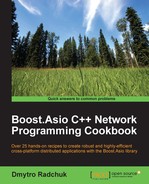In today's information-centric globalized world, telecommunications have become an essential part of our lives. They penetrate and play crucial roles in almost every aspect of our day-to-day activities, from personal to professional. Sometimes, a failure to communicate information correctly and on time may lead to significant loss of material assets or even casualties.
Therefore, it is very important to provide the highest level of reliability when it comes to developing telecommunication software. However, it can be a really challenging task due to the inherent complexity of the domain and accidental complexity of the low-level tools provided by modern operating systems.
The Boost.Asio library is aimed at reducing accidental complexity by introducing type systems and exploiting object-oriented methods, and decreasing the development time by providing high degrees of reusability. In addition to this, because the library is cross-platform, the applications implemented with it can be built on multiple platforms, which enhances software qualities even more, while decreasing its costs.
This book contains more than 30 recipes—step-by-step solutions to various tasks that often (and not so often) arise in the area of network programming. All recipes take advantage of facilities provided by the Boost.Asio library, demonstrating best practices of applying the library to execute typical tasks and solve different problems.
Chapter 1, The Basics, introduces you to basic classes provided by the Boost.Asio library and demonstrates how to execute basic operations, such as resolving a DNS name, connecting a socket, accepting a connection, and so on.
Chapter 2, I/O Operations, demonstrates how to perform individual network I/O operations, both synchronous and asynchronous.
Chapter 3, Implementing Client Applications, contains recipes that demonstrate how to implement different types of client applications.
Chapter 4, Implementing Server Applications, contains recipes that demonstrate how to implement different types of server applications.
Chapter 5, HTTP and SSL/TLS, covers more advanced topics on the HTTP and SSL/TLS protocol implementation.
Chapter 6, Other Topics, includes recipes that discuss less popular but still quite important topics, such as timers, socket options, composite buffers, and others.
